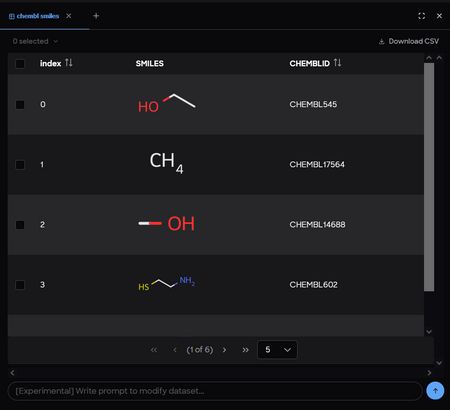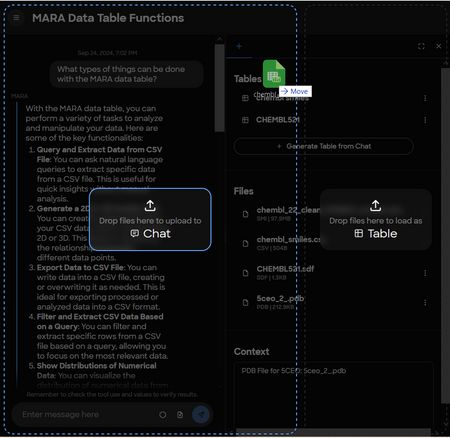# Features
# Chat
This is the primary interface for interacting with MARA. It is a chat interface that can help you analyze and reason about molecular data by constructing workflows of tools to achieve a specific goal.

Here are some examples of the types of tasks MARA can accomplish:
- Data Retrieval:
- Downloading PDB files for specific proteins.
- Retrieving SMILES strings for given compounds.
- Extracting protein sequences from PDB or mmCIF files.
- Data Conversion:
- Converting PDB files to mmCIF files and vice versa.
- Converting SMILES strings to 3D structures.
- Converting molecular dynamics (MD) trajectories to PDB files.
- Informatics:
- Calculating chemical descriptors for lists of SMILES.
- Finding similar compounds in databases like ChEMBL using SMILES strings.
- Generating molecular fingerprints from SMILES.
- Analysis:
- Aligning reference polymer structures to sets of mobile structures.
- Computing solvent accessible surface area (SASA) of proteins.
- Calculating RMSD from MD trajectories.
- Visualization:
- Drawing 2D structures of molecules from SMILES strings.
- Generating 3D conformers for given molecules.
- Displaying protein sequences and alignments visually.
# Chat Input

Hexagon button opens the chemical structure drawing tool
Upload buttons opens a file picker to select files to upload
(December 2024) MAE, MOE, and PSE session files can also be uploaded to a chat prompt.
# Data Table
With the MARA data table, you can perform a variety of tasks to analyze and manipulate your data.

Here are some of the key functionalities:
- Query and Extract Data from Table: You can ask natural language queries to extract specific data from a CSV file. This is useful for quick insights without manual analysis.
- Generate a 2D or 3D Scatter Plot: You can create scatter plots from your CSV data, which can be either 2D or 3D. This helps in visualizing the relationships between different data points.
- Export Data to CSV File: You can write data into a CSV file, creating or overwriting it as needed. This is ideal for exporting processed or analyzed data into a CSV format.
- Filter and Extract CSV Data Based on a Query: You can filter and extract specific rows from a CSV file based on a query, allowing you to focus on the most relevant data.
- Show Distributions of Numerical Data: You can visualize the distribution of numerical data from a CSV file, which can help in understanding the spread and central tendencies of your data.
- Understand CSV File Content: You can get a summary or overview of the contents of a CSV file, which can be useful for initial data exploration.
These tools provide a comprehensive suite for handling and analyzing data tables, making it easier to derive meaningful insights from your datasets.
# Creating Tables
You can create a table by uploading a CSV file through the Chat input, or by dragging and dropping a file into the interface.

Supported file types for tables: .csv, .xlsx
# Molecular Visualization
MARA allows you to visualize structures in 3D using Molstar, and update the representation using natural language.

Example Prompts:
- Show all residues in chain D as ball and stick
- Color residues 101-207 blue
- Hide waters
- Spin the molecule
- Focus on ligand 50D
- Download as [ molx| stl | obj | glb | usdz ]
- Highlight residues 149-150 in green
- Set style to illustrative
